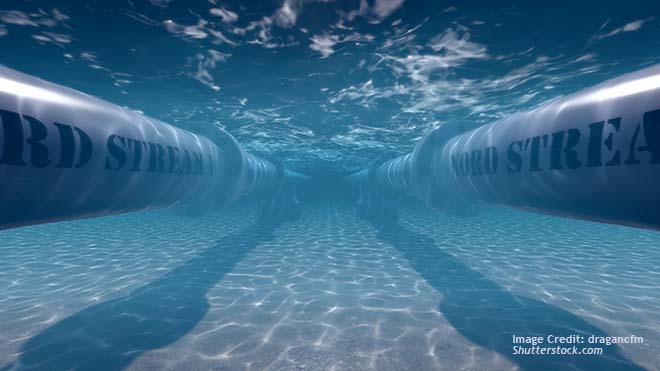The Sabotage of Nord Stream 1 & 2

The first reports of unusual tremors in Østersøen, adjacent to the Island of Bornholm, were transmitted to the Danish authorities on September 26. These tremors were the result of explosions on the gas pipelines Nord Stream 1 & 2. Before the Russian-Ukrainian war, the gas pipelines were used to transfer natural gas from Russia to Europe. However, the pipelines were closed down as a consequence of Russia’s aggression in Ukraine, which led to reciprocal sanctions between Europe and Russia.
The day following the explosions, Denmark’s Premier Minister Mette Frederiksen declared that the incidents were not accidents, but did not specify who was to blame for these. Many European leaders, Ukrainian President Zelensky as well as the Premier Minister of Poland, did, however, accuse Russia of the sabotage. China and Russia responded to the accusations of Russia’s involvement and have blamed President Biden for the incident.
Naturally, both sides are trying to control the narrative of the incident. For example, since the Russian invasion of Ukraine in February, the information war between the West and Russia has escalated tremendously, with information warfare playing a significant role in Russia’s hybrid warfare strategy with the purpose of gaining support and delegitimizing the west and its leaders. In relation to the sabotage on Nord Stream 1 & 2, the two sides’ accusations of one another and dispute over who gets to shape the narrative contributes to new uncertainties and potential conflict escalation, especially in light of the fact that the incident occurred in Denmark’s Exclusive Economic Zone (EEZ), a NATO member. Little information about the incident has been revealed so far which consequently leaves room for these speculations and unsupported accusations. Denmark will be the country leading the investigation of the sabotage of Nord Stream 1 & 2.
What We Currently Know
The Danish authorities hosted a press meeting on the 28th of September disclosing that all evidence until then confirmed that the explosions were intentional and could not have occurred by themselves; Therefore, not an accident. The Danish authorities additionally announced that a thorough and transparent investigation of the incident, in close cooperation with the Swedish and German authorities, will be conducted.
Danish Foreign Minister Jeppe Kofod likewise announced that after his discussion about the incident with the American Foreign Minister Anthony Blinken, Denmark “is coordinating the situation closely with the U.S. and other allies when it comes what to next. We will get to the bottom of this and take collective actions.” However, the investigation cannot begin till the remaining gas has left the pipes. Danish Minister of Defense Morten Bødskov revealed after his meeting with NATO’s General Secretary Jens Stoltenberg that the investigation could first be conducted roughly two weeks after the incident.
The Baltic Pipeline
The fact that Poland and Denmark celebrated the launch of the Baltic pipeline the day before the sabotage on Nord Stream 1 & 2 must, undoubtedly, have inflamed tensions in Moscow despite the lack of information and unfounded claims from both sides. The Baltic gas pipeline will transport gas from Norway to Poland and subsequently to Europe, reducing Europe’s reliance on Russian gas as a result.
Thus, the launch of the Baltic pipeline would diminish Russia’s leverage over Europe. Military analyst Anders Puck Nielsen from the Danish Defense Academy has reported, to the media DR, the destruction of the gas pipelines had no detrimental ramifications for Russia since Nord Stream 1 & 2 were no longer transporting gas from Russia to Europe. The Danish authorities, have nevertheless, because of the sabotage of Nord Stream 1 & 2, heightened security surrounding the Baltic pipeline.
Denmark’s Reaction
Regardless of Danish Premier Minister Mette Frederiksen’s claim that the sabotage of Nord Stream 1 & 2 was “not an attack on Denmark” since it occurred in Denmark’s EEZ, and therefore in international waters, the incidence has resulted in higher surveillance of critical infrastructure in Denmark and in its neighboring countries. Denmark’s response thus far has been to deploy ships, ranging from a battleship to an environmental ship (miljøskib), with the purpose of controlling and securing the region. The emergency level near Bornholm has been raised to orange, which is the second highest level in Denmark. Only a week after the incident occurred, the heightened surveillance has proven necessary.
In both Norway and Denmark, suspicious drone activity has been observed especially in areas with critical energy structures such as drilling rigs and other gas and oil installations. The Joint Expeditionary Force (JEF) released a statement, after a virtual meeting on the 3rd of October, condemning the sabotage and promising to take collective measures by increasing its maritime presence and intelligence surveillance and reconnaissance activities. The JEF also stated that the gathered information would be shared and ensured only to act complementary and in alignment with NATO as well as with investigation led by Denmark, Sweden, and Germany.
Due to concerns for the operation’s security, the Danish Military notified the Danish news outlet DR later that day that no additional details of the inquiry will be made public. Therefore, it will be weeks before any intelligence on the sabotage and, consequently, who is to blame, is disclosed. In the meanwhile, transparency, when possible, will be of the outmost importance to control the narrative, hence the information war, to secure some form of stability and reassurance in a chaotic and insecure situation.